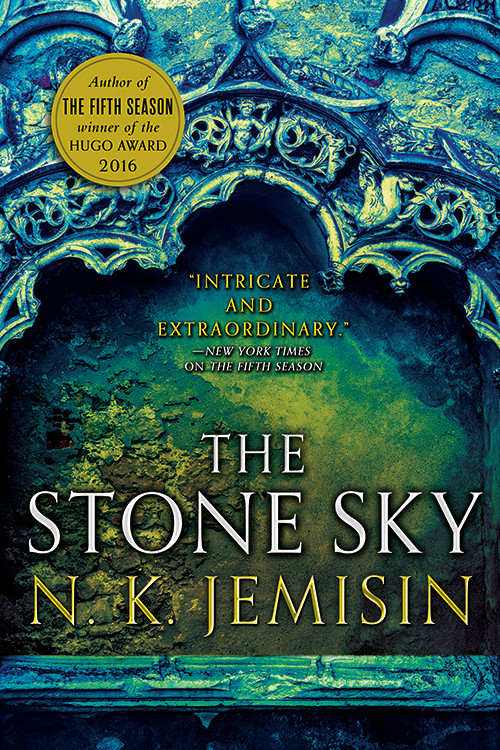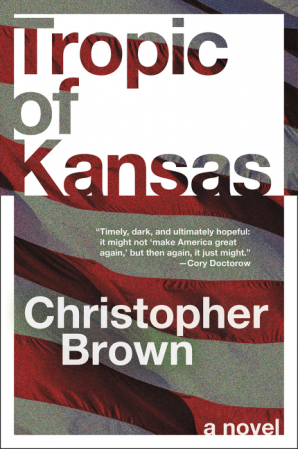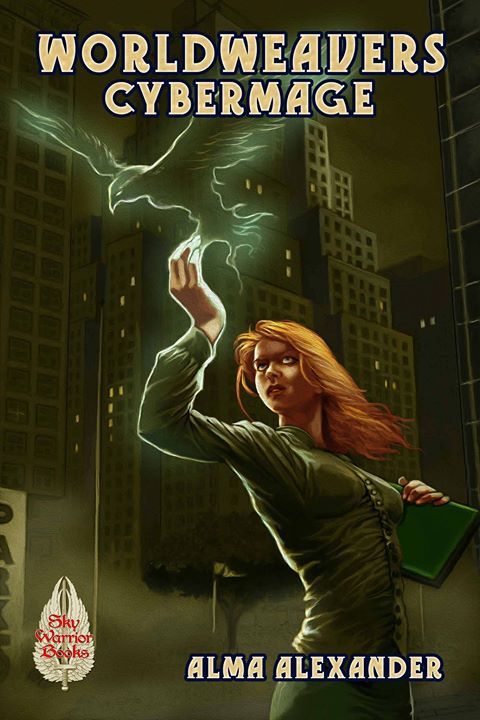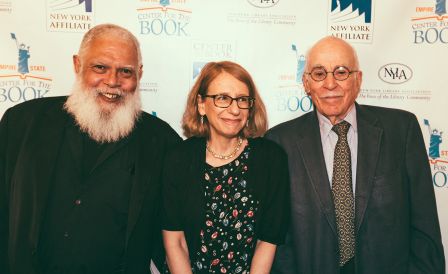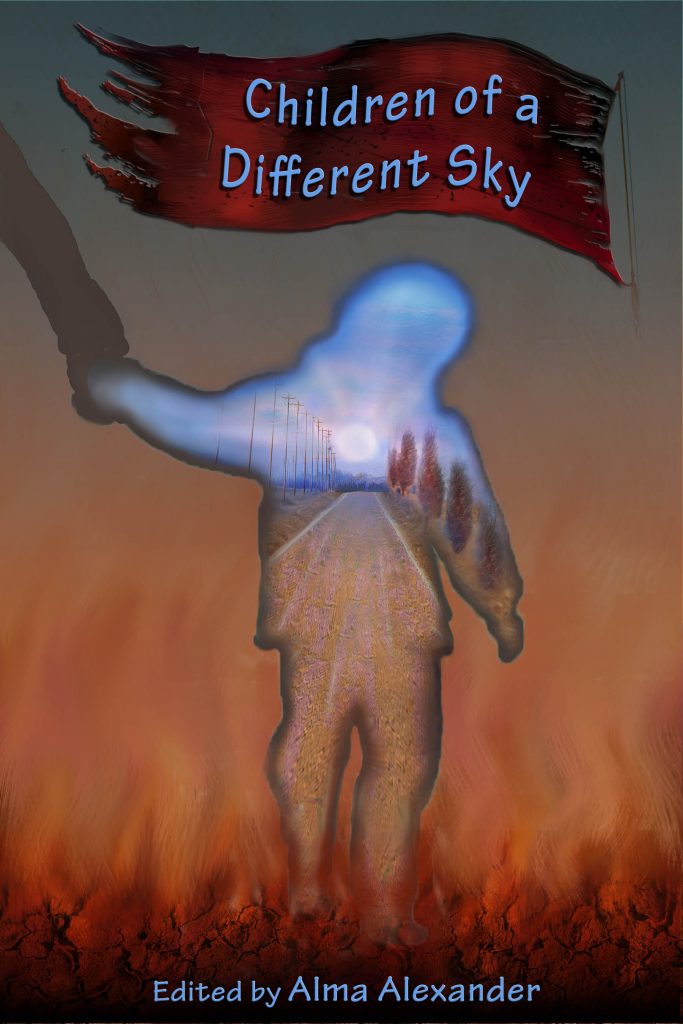
By Carl Slaughter: Keep watching for Alma Alexander’s new collection, Children of a Different Sky, coming out this Fall. It is a themed fantasy anthology, about migrants and refugees, and it is a charity anthology, with all the profits from the sales of the book above anything required for housekeeping and production are going straight to two selected charities working with refugees and migrants both in the USA and globally.
CARL SLAUGHTER: What prompted you to do an anthology with this theme?

Alma Alexander
ALMA ALEXANDER: There are seven words that underlie the status of any refugee in the world, ever: “There but for the grace of God…”
It is not a new issue — people who run from disaster in the hope of finding a better future have always been with us. But what IS new is that now it is all being televised on 24-hour 7-days-a-week news channels, always available online on news websites.
We can no longer hide from the misery of these displaced souls because we see them running now — we see them on the crowded boats on open seas, we see them clawing to shore and drowning on the doorstep of salvation, we see them languish in camps where conditions are enough to horrify any sane mind, we see them crowding against barbed wire and against walls and being denied harbor because they are hated and feared and basically unwanted by the populace already on the ground in the places where the migrants wish to go. People who cannot see that the refugees in this restless and lost crowd might one day, some day, just as easily be themselves.
We see them being stamped on the forehead with their ethnic identity and country of origin, and being denied visas in pieces of legislation from the top of the world’s governments – meeting quotas, or banning outright anyone from country X on the basis that they were born there.
I never ran from a “hot war” but I have family who have done just that. And I, myself, left the country of my birth when I was very young – and got set adrift on the currents of the world. On the one I gained the life experience of living in seven different countries on four different continents before I was 40; On the other hand I lost the threads that bound me to my place of origin, making me a cultural refugee.
It was possibly the reframing of my own existence in those terms that made me eager to do what I could to help other people in a similar or worse situation, and the only way open to do that for someone like myself is to do that thing that I do – Tell Stories. And since there is always strength in numbers and I knew many stellar writers whom I knew I could ask to help this endeavour and who, if they were on board, would make a magnificent contribution.
That is how Children of a Different Sky came to be.
CS: Why does the speculative fiction community need stories about refugees and immigrants?
AA: I have always strongly believed that fantasy — not just any stripe of fiction but sometimes outright fantasy — is the only way to tell the real truth.
It isn’t that the speculative fiction community needs stories about refugees and immigrants – it’s that the WORLD does, in order to understand ourselves. These days more than ever just casting one’s eyes over the day’s headlines is enough to make anyone sane want to dive under the covers and refuse to get out of bed. It’s overwhelming, because it’s all too real, happening right now, happening to all of us, and we are all individually too small and too helpless to do anything about it.
But when we pick up a story, we can take that one necessary step back, take a deep breath and since all these things happen to someone in that story rather than to ourselves we can find ways to feel empathy and outrage and anger — and perhaps the strength to take whatever small steps each of us individually can in order to right the world’s gigantic wrongs.
This vision, this strength, this is something that is a gift that speculative fiction can offer — and learning about others, other human beings who have felt the kind of loss and dislocation that any migrant can tell you about, is much easier and much DEEPER when viewed through that thin silver tissue of lies that is fantasy. What we bring is not “truth and nothing but the truth” – but the emotional truth, the human truth. Without that underlay everything is just statistics.
We aren’t telling individuals’ own “true” stories here. First and foremost, we cannot, because these are THEIR stories and not ours and they will choose when or how to tell them. But we are telling stories LIKE theirs, in the hope of shining a light into the dark places where silence can no longer be permitted to linger. We, and our stories, are pulling the curtains open adn saying, look, look at this stage and at the people suffering on it.
CS: Are there any modern parallels?
AA: All you need to do is turn on the television, scan the news of the day on your phone, even pick up that dying purveyor of news which our ancestors knew as the newspaper (fewer and fewer of those. I don’t think I know many people who read an actual paper these days, and some of THOSE only when they’re handed the thing while staying at a hotel or something, as a stopgap measure before they can get back to a digital existence…)
Human migration has always been with us – but it’s only in recent years that it’s become a sort of horrible terrifying reality show. These days you can easily pick up images of bleeding and shell-shocked kids, of women clutching a baby in one hand and a pathetic bundle of possessions in another, of desperate men pushing their families into overcrowded boats and pushing the boats away onto the waters not knowing if they will ever see them again. The sheer weight of heartbreak on the TV news every night can be overwhelming.
And there are always the historical underlays to go back to – things like the concentration camps which awaited those who could not become refugees back in 1940s Germany, and in numberless other places. There is always that dichotomy of taking in those who are fleeing and being afraid to take them in because those already on the ground are afraid of being overwhelmed by them. And yet we keep on creating circumstances, mostly wars, which dislocate more and more people and send them on this endless quest for sanctuary in places strange to them, places which will insist that they lay aside all the things that make them who they are in order to enable them to integrate into a new and unfamiliar place.
The choices are stark, and are made every day, right here, right now – take in everyone? Pick and choose? Pick and choose how? And what if you turn away the little boy who will grow up to become another Steve Jobs, or a little girl who might grow up and find a cure for cancer, or a woman who might give birth to either of those children…?
CS: Are there any personal connections?
AA: I began to consider myself a “cultural refugee”, someone who had left behind a native culture as a child and has been unmoored ever since. I have immediate family – a first cousin and (at that time) two very young kids one of whom was still in a stroller – who ran from actual bombs and whose safety was very much an issue at the time. I come from a country which no longer exists, anyway, so I am a refugee in that sense, too. I claim provenance from a place no longer on the maps of the world. So yes, personal connections, in that sense.
But also – I am a storyteller, an empath. I look into the eyes of a child sitting hopeless and hungry in the middle of a row of muddy or dusty tents (it is a blessing if it rains… it is a blessing if it does not…) and I see a yawning chasm of terror and despair. Oh yes, it’s personal. I can see a human being suffer through no fault of their own and my heart goes out to them all.
CS: What lessons do we take away from these stories?
AA: We are all human. We need to take care of each other. We NEED to. We need to understand that it isn’t a zero sum game, that it simply isn’t true that for someone to win somebody else has to lose everything.
There has to be a way that our existence matters, has value, and treating any one of us like vermin or worse like collateral damage of no value at all devalues us all. We are human beings, and we have hands and hearts and consciences and spirit and understanding. We are better than our worst aspects. We have to be. We need to live up to our own potential.
Telling stories is one way to bring issues like that to the forefront where they can be picked up and turned over and thought about… maybe that’s what it takes for somebody to gain an understanding of the ties that bind us all.
CS: Are the stories originals, reprints, or both?
AA: Two reprints (one story, one poem) and the rest are all luminous, amazing, astonishing originals written for this book.
CS: What was the selection process?
AA: There was a core of stories which were solicited from participating authors; there was also an open reading period and several stories came from that “slushpile”, some from names already active in the genre and at least one from a writer who had never submitted a story anywhere before.
The theme of the anthology was the migrant/immigrant/refugee experience, and the story criteria were simple enough: “Make me think; make me feel.”
And oh boy, did the stories in this book deliver on those terms. As an editor, this is a collection of which I am very proud. As a reader…this is one of the most luminous collection of stories I have ever seen in one place. This anthology began as a project with an idea – a charity anthology with proceeds of sales to go to organizations helping migrants and refugees on the ground. During the process of its incarnation, it grew into a living thing with breath and heartbeat. And every story and poem in this book is one essential component of this transformation.
CS: Are you at liberty to identify the NGOs that will benefit from this project?
AA: The organizations chosen as recipients of the proceeds from the sale of this book were chosen by the anthology’s participants from a curated shortlist, That list included some really big fish in this area — organizations such as Unicef, and Doctors WIthout Borders – but those are entities which already, by default, because everyone has heard of them and that’s where they go if they want to make a donation, have a large and remunerative following.
We eventually decided to go with one major recipient, a smaller and more focused organization, the International Medical Corps, and (because one of our authors already has an established connection there) a recipient in the Center for New Americans in Massachusetts.
CS: What’s on the horizon for Alma Alexander?
AA: I’m currently working on a new historical fantasy novel, and also tinkering with a new (single author) short story collection, which is at the stage of lacking a couple of key stories that still need to be written — but I am hopeful of getting those ducks in a row soon so at the very least that is likely to see the light of day in 2018. In the meantime, there are several books which will be seeing reissues in the coming year or two, some newly “remastered” as it were. And I’m mulling the idea for another anthology, soon…
FIND ALMA ALEXANDER ON SOCIAL MEDIA











